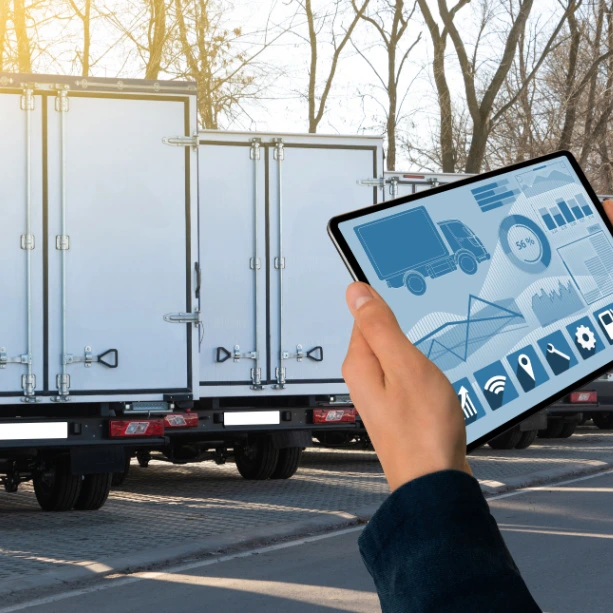Since the introduction of the popular consumer product Apple AirTag, companies have been trying to accomplish the same level of visibility at an enterprise level. The search for visibility is seen especially in logistics, with fleet managers seeking full visibility of their supply chain operations. They have visibility of the trucks in their fleet thanks to telematics, but desire the same visibility extended to the trailer and the assets on the trailer. What they are looking for is a trailer tracker. For a time, the obvious choice seemed to be the AirTag, but when applied in such a setting, it was found to not work as well as companies thought it would. So the question becomes, what is the best solution? You’ll find the answer in this blog.
Increase Your ROI by Investing in AirFinder Everywhere
- Loss Prevention. Reduce the amount of loss that occurs during the supply chain process
- Location Coverage. AirFinder Everywhere uses a combination of GPS, Cellular, and WiFi to determine location everywhere
- Security Alerts. Know when a delay in shipment has occurred so the problem
can be addressed immediately.
What Classifies a Trailer Tracker?
In a general sense, a trailer tracker is anything that has the capability to track your trailers. Trailer trackers are used to monitor and track the location and status of trailers or other types of towed equipment. Typically, fleet managers invest in a GPS trailer tracker, but that is not the only option available. It’s also worth noting that just because a solution is available, doesn’t make it the best solution for you.
Tracking Ability
This first thing that defines a trailer tracking solution is the ability to track trailers. What this means varies depending on your goals and the scope of your operations. Some consider barcode scanners as a trailer tracking solution. This is because you are scanning a barcode and putting it on a trailer, providing a record of where the asset is based on the scan. If that’s what you want for your company, you’re welcome to use that, but it won’t give you complete visibility. Complete visibility comes from automated tracking of trailers. You also need to determine what level of visibility you need. If you just want to track your trailers, then you’ll choose a solution that allows you to do so. However, some fleet managers want visibility inside of their trailers, too. This can include pallet tracking and cargo tracking, which are more granular aspects of tracking the trailer itself. If the solution you choose doesn’t have the ability to scale to the level you need, then you need to choose a different one that will. Sometimes, that all depends on the technology of the solution.
Technology
Different technologies provide different location accuracies. Depending on your use case, you’ll have your pick of any number of location technologies. You may have heard of Bluetooth LE and UWB for indoor environments, but those don’t translate well for a trailer when it’s on the road. Trailer tracking GPS technology is top of mind for fleet managers looking to invest in a trailer tracker. This is because GPS is one of the most accurate technologies on the market. The drawback to using GPS is how power hungry it is, especially in areas with low visibility. The more battery used, the quicker you have to change the battery, or if the tag isn’t replaceable, you have to pay to replace the device. To maximize the ROI on your investment, you need to find a balance between accuracy and affordability.
Our trailer tracking system, AirFinder Everywhere uses a combination of GPS, Cellular, and WiFi. If you want the location accuracy of GPS technology, you can have it. If there is little to no signal, instead of draining the battery on GPS trying to find one, the tag will switch to your choice of cellular or WiFi to keep trying to find as close of a location as possible. This way, your battery life lasts up to 7 years instead of only a few months. At the end of the day, getting within a quarter mile every once in a while is a whole lot better than all the money you have to spend replacing the tag every few months. Since you’re managing a fleet of vehicles, it’s safe to assume they spend most of their time on a highway. A one-quarter range on a highway is a lot easier to search than trying to find a trailer with a tag whose battery died while looking for a signal.
Sensors
Did you know that some trailer trackers have sensors embedded in them to monitor environmental factors like temperature and humidity? Depending on what you are transporting, having sensors may be something you deem necessary when choosing a trailer tracking device. If you participate in the cold supply chain, then you want to choose a tag that monitors temperature. This is helpful to have in emergency situations when the trailer’s refrigerator brakes. Or sometimes the trailer is packed incorrectly, leading to vents being covered. These types of problems often go unnoticed until it’s too late, leading to spoilage and waste. Tags with temperature sensors can be attached to the trailer and/or the cargo itself to help prevent this from happening. When you set up the tag, you select a “safe zone” for the temperature to remain in. If the temperature in the environment breaches that zone, you’ll receive an alert so you can address the situation before spoilage occurs. This helps to ensure that cargo being transported remains safe. If you would benefit from any type of environmental monitoring, then you should choose a solution that has that capability.
Integration
If you manage a fleet, then you already have telematics integrated in your trucks. If you decide to invest in trailer tracking, you are still going to use your telematics solution. After all, they work in tandem together, each filling in the gaps that the other leaves open. Since you have a telematics system in place already, you want to make sure your trailer tracker can integrate with the telematics system. If the trailer tracking software can integrate with your telematics software, then all of your fleet data will be in one location. Any data you need on truck usage, driver behavior, or trailer location for decision making is simply in one location. Without integration, you have your data spread across multiple locations. Without comprehensive fleet management, strategic decisions take longer to make. It’s a common misconception by fleet managers that they either need telematics or a trailer tracker, when in reality, the two work hand in hand to provide complete visibility of logistics operations. With just telematics, you’re limited to visibility of the truck. With just trailer tracking, you’re limited to visibility of the trailer. With the two, you have it all and integration makes everything easier.
What is the AirTag?
The AirTag is a tracking device created to help people find their everyday items when they get misplaced. It is not a tracker for a trailer. The small tag allows you to identify missing items within a small range. If the asset you’re looking for goes beyond just 20 feet or has multiple path options to get there, the tag will struggle to identify the location of the asset accurately, if it can at all. The AirTag may turn on “Lost mode” so it will alert you when the asset is back in range, but this is not a practical solution for when you need the trailer you’re looking for at that exact moment. If you’re investing in an asset tracking solution, you need it to actually find your assets, not just when it turns back up. While the AirTag helps you find your wallet and keys, it doesn’t have the capability to track assets at a commercial scale. The AirTag was created to help you find personal items, not your trailer that fell to the hands of misuse. To gain benefit from the solution you’re investing in, choose a solution that was created to find your assets at a commercial level.
If Not the AirTag, What Then?
You should invest in a trailer tracking solution that was developed to be used for trailer tracking. The AirTag was not created to be a trailer tracker, but our AirFinder Everywhere solution was. Our solution, as mentioned above, uses GPS, cellular, and WiFi sniffing to provide accurate location information while preserving battery life. This technology is meant to determine an asset’s location at a long range. If you’re looking for a trailer, odds are it isn’t 15 feet away from you, otherwise you would see it. So you need a technology, like GPS, that can tell you where it is even when it’s states away. Our tags have embedded sensors that monitor environmental conditions. If this feature is important to your company, then you have to choose the solution that has this feature. Even more, it integrates with your existing telematics solution. This way, when you want information on your fleet operations, everything you would need to know is in one location for you.
Will You Invest in the Best Trailer Tracker?
While the AirTag has proven to be a helpful solution at a personal level, it has proven to be a hindrance at a commercial level. If you’re looking for a trailer tracker, choose the solution that was developed to be a trailer tracker, not the one that helps you track your keys. Choose our AirFinder solution so you can gain complete visibility of your supply chain operations. To learn about the results you’ll see by using our solution, book a demo with our team.

Publisher: Source link











